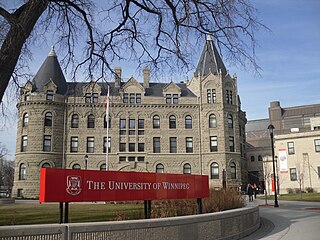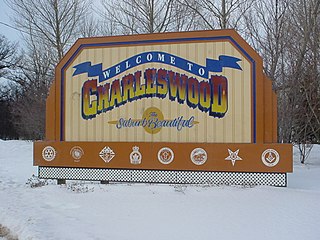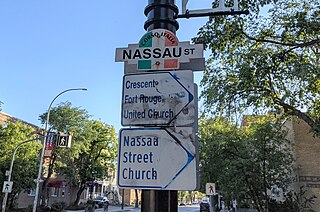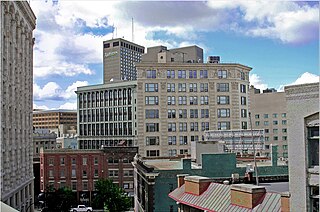
Winnipeg is the capital and largest city of the province of Manitoba in Canada. It is centred on the confluence of the Red and Assiniboine rivers, near the longitudinal centre of North America. As of 2021, Winnipeg had a city population of 749,607 and a metropolitan population of 834,678, making it Canada's sixth-largest city and eighth-largest metropolitan area.

St-Boniface is a city ward and neighbourhood in Winnipeg. Along with being the centre of the Franco-Manitoban community, it ranks as the largest francophone community in Western Canada.

Charleswood is a residential community and neighbourhood in Winnipeg, Manitoba, Canada. It is located in the South-West of the city and is bordered by the neighbourhoods Tuxedo to the East, Fort Whyte to the South, and the Rural Municipality of Headingley on the West. Its boundaries are Roblin and the Assiniboine River to the north, Shaftesbury Boulevard on the East, Wilkes Avenue to the South and the Perimeter Highway to the West.

Tuxedo is a residential suburb of Winnipeg, Manitoba. It is located about 7 kilometres southwest of downtown Winnipeg and borders the Assiniboine River and Assiniboine Park on the north, Shaftesbury Boulevard on the west, Route 90 to the East and McGillvary Boulevard to the South. Prior to 1972, the community was incorporated as the Town of Tuxedo.
Academy Road is a street in Winnipeg, Manitoba, Canada. It runs from the Maryland Bridge to Wellington Crescent, just west of Route 90, and actually intersects with Wellington at both its east and west ends. Academy Road is located in the residential neighbourhood of River Heights and has many retail stores along it.
Old Kildonan is the northernmost city ward of Winnipeg, Manitoba. Before the City of Winnipeg Act of 1972, it was an independent unincorporated municipality called the Municipality of Old Kildonan; prior to that, from 1914, it was a subdivision of the Rural Municipality of Kildonan.
St. Vital is a ward and neighbourhood of Winnipeg, Manitoba, Canada.

Nassau Street is a 2-kilometre (1.2 mi) street in Winnipeg, Manitoba, located partially within the Osborne Village and Fort Rouge neighbourhoods.

The amalgamation of Winnipeg, Manitoba was the municipal incorporation of the old City of Winnipeg, eleven surrounding municipalities, and the Metropolitan Corporation of Greater Winnipeg (Metro) into one.

St. James-Assiniboia is a major community area in Winnipeg, Manitoba, Canada. As it encapsulates most of the city ward of St. James, which includes the major St. James Street, the area itself is often simply referred to "St. James."

Downtown Winnipeg is an area of Winnipeg located near the confluence of the Red and Assiniboine rivers. It is the oldest urban area in Winnipeg, and is home to the city's commercial core, city hall, the seat of Manitoba's provincial government, and a number of major attractions and institutions.

The Exchange District is a National Historic Site of Canada in the downtown area of Winnipeg, Manitoba, Canada. Just one block north of Portage and Main, the Exchange District comprises twenty city blocks and approximately 150 heritage buildings, and it is known for its intact early 20th century collection of warehouses, financial institutions, and early terracotta-clad skyscrapers.

The West End is a mostly residential area of Downtown Winnipeg, Manitoba, Canada. It includes the neighbourhoods of Armstrong's Point, Colony, Daniel McIntyre, Minto, Sargent Park, Spence, St. Matthews, West Broadway, and Wolseley.

Winnipeg's North End is a large urban area located to the north and northwest of Downtown Winnipeg. It is bordered by the Red River on the east, the Canadian Pacific Railway (CPR) mainline on the south, the City of Winnipeg boundary on the west and Jefferson Avenue, Keewatin Street, Carruthers Avenue, McGregor Street and the lane between McAdam and Smithfield Avenues on the north. It is the northern section of the City of Winnipeg as it existed prior to the 1972 municipal amalgamation. Winnipeg's northern suburbs such as West Kildonan and Old Kildonan are not considered part of the North End. The CPR mainline and its Winnipeg yards, which are one of the largest railway yards in the world, act as a physical barrier between the North End and the rest of Winnipeg to the south. This has resulted in the North End remaining a very distinct and unique part of Winnipeg.
The municipal government of Winnipeg is represented by 15 city councillors and a mayor elected every four years.
Marlton is one of the original neighbourhoods in the area of Charleswood in Winnipeg, Manitoba. It is bordered by Roblin Boulevard, bisects Tom Chester park to the east and Grant Avenue to the south.
David Paul Penner was a Canadian architect from Osborne Village in Winnipeg, Manitoba. He attended the University of Manitoba where he received his Bachelor of Environment Studies in 1979 and Masters of Architecture in 1985. Penner was the founding principal of David Penner Architect (DPA). He became a Fellow of the RAIC in 2012, and was involved in several organizations outside his firm including Storefront Manitoba and the Prairie Design Awards Program. His best-known architectural works include Fountain Springs Housing, Buhler Center, Windsor Park Library, and Mere Hotel. Penner died from a heart attack on January 7, 2020.
Old Tuxedo is an affluent residential suburban neighbourhood in Tuxedo, Winnipeg. It is bounded by the Assiniboine River to the North, Park Boulevard N to the west, Tuxedo Avenue and Roblin Boulevard to the south and Route 90 to the east.











